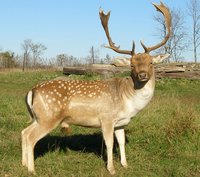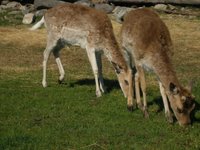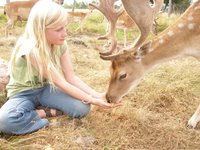There are 13 male fallow deer in our current herd who are are conditioned to come to people when they hear the banging of a metal pail. Around 3pm they seem to congregate under one of the shade trees in G, not far from the red barn door where we always enter as if anticipating our arrival, unless there has been some event to scare them such as high wind, loud party, braying donkey, etc.
Each deer loves corn. Some prefer apples to carrots but will eat carrots if cut in quite small pieces. We

spread corn over a large area, not in a straight line, so that each one can get some, even those who don’t like to come too close to people.
We have had some success spreading out the corn along the dry creek bedrock and in a circle around the rocks to the left of the red barn. We sit quietly on rocks in the middle of the circle. The deer will come quite close from all directions. George eats out of our hands and Scratch will eat from the rocks quite close to us.
We have been rewarding the deer with apples or carrots when they come close to us or make eye contact and “ask” for food. At first they were skittish when we tossed the food to their feet, but most now are not frightened by our underhand throws. Occasionally we hit one with a piece of apple or carrot but some are not worried by that. When nervous most deer will run a short distance away and then walk back to the feeding area.
The deer are still very sensitive to any quick movements by people and different noises such as clicking of a camera or a truck backing up. If we quietly speak in reassuring tones, “It’s okay, okay” they often calm down and return to feeding. George is now not spooked by the sound of our voices or our laughter.
Although there is a bit of shoving going on when feeding, the bucks are not being too aggressive with one another and seem to be getting along. Occasionally George will nip Scratch on the shoulder or rump and some of the others have done this to each other too. Two bucks will rear up onto their hind legs and shove each other. It seems to be over when the one who is pushed back onto four legs first moves away.
****
Identifying the Deer by Groups & Behaviour at Feeding Time
The herd numbers 13 and we have decided to divide the group into different sections which makes it easier to identify individual deer and groups. Each of the individuals now has a name.
Group One – Largest – 3 individuals
(Super) Max, very social, leads deer away after he decides feeding ends.
Mike, somewhat social
Dandy, somewhat social
Group Two – White & Large – 3 individuals
Buddy, somewhat social
Bash, somewhat shy
Gulliver, social but unpredictable
Group Three – Brown, Mid-size – 4 individuals
George, very social, sometimes leader
Scratch, very social
Murph, somewhat social
Ty, somewhat shy
Group Four – Small, white – 2 individuals
Spike, somewhat social
Moki, somewhat shy
Group Five – dark, adult, eldest? – 1 individual
Koko, social but easily spooked
Group One – LARGEST
1. (Super) Max
Seems to be the tallest and has most body weight, largest antler growth
Comfortable around people, and will come close for apples and carrots
Not challenged for food by the others and does his own thing.
One of three largest deer with largest antlers and similar colouring
Usually leads group from one area to another after feeding is over
Large antlers are symmetrical, front antlers form an open, even U shape
2. Mike
Very large deer similar in size and colouring to Max
Hangs out with Max, a bit less courageous
Has non-symmetrical antlers, an odd lump/spike on one antler (left)
Front antlers come quite close together
3. Dandy
Very large deer similar in size and colouring to Max
Least social of three large deer
Front antlers asymmetrical
Group Two -- WHITEST
1. Buddy
About the same size as George, slightly darker face
White legs and undercarriage, pale antlers
Obvious white horizontal stripe halfway across from hips to shoulders
Was social earlier in spring but has become more tentative and shy
2. Bash(ful)
Whitish face with dark eyes, whitish body and legs
Large pale antlers with pinkish tones
Stays as far away from people as he can and still get to any corn.
Starting to look at feeders
3. Gulliver (returned June 1, 2006)
White legs similar to Buddy in colouring
Antlers have a whitish fur, one of the largest deer
Wanderlust, distrustful of people at first, now social but unpredictable
Group Three – MID SIZE
1. (Curious) George
George has a black spot on his right eyelid above the outside top corner of his eye.
His antlers are dark.
His grey tag is about 2/3 way between his head and the tip of his left ear, closer to the tip (No. 96073T7).
He is usually the first to approach people and comes the closest
He accepts apple and corn from hand and lets you touch his antlers and nose
He seems to be the leader of the younger bucks.
He will follow a feeder who walks away from him
2. Scratch
Looks almost the same as George
Quite social and almost takes corn from hand
Dark antlers with an odd lump on his left antler only
3. Murph
Looks similar to George in size and colouring
Darkest hair on forehead
4. Ty
Tawny colouring in face and antlers
Shyest but starting to look at feeders
Group Four – SMALLEST
1. Spike
Most social of the smaller bucks
Lighter colouring than Moki, white belly bleeds into chestnut top
Makes eye contact when he wants an apple, prefers corn
Likes to watch people
2. Moki (native American for “deer”)
He is about the same size as Spike
His coat is slightly darker than Spike’s, chestnut colouring below his horizontal belly line
Does not often make eye contact with humans
Doesn’t like apples too much, prefers corn
Sometimes spaces out
Group Five – DARKEST
1. KoKo
Darkest brown face and neck
Body dark brown, too
Getting comfortable with people, loves apples
Smaller trunk and shorter than the largest deer
Social but easily spooked.
Allan Park
Jane McDonald
July 14, 2006







































